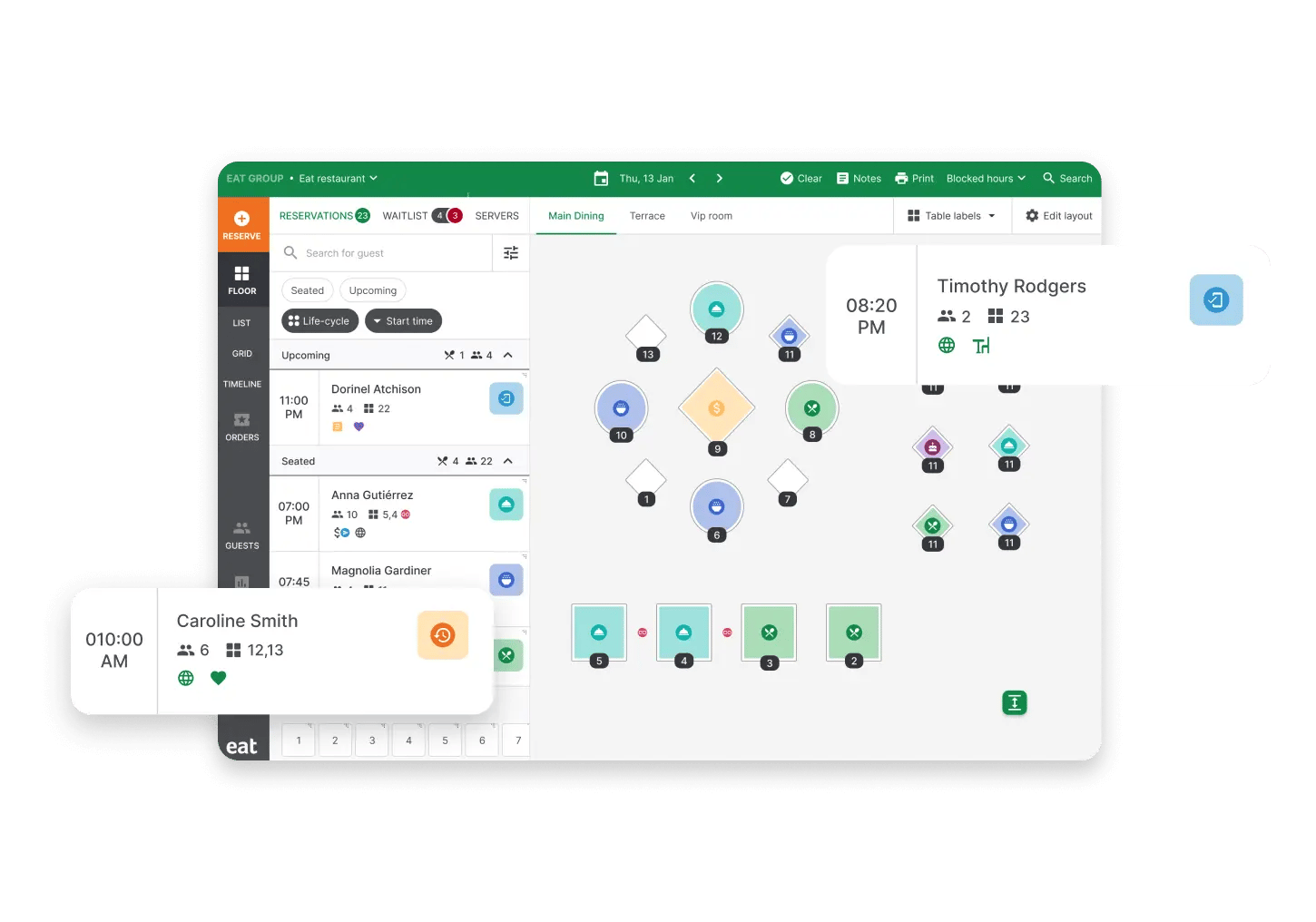Fine dining restaurant is more than just a restaurant with excellent food.
Running a fine-dining restaurant is about creating a perfect dine-in experience and making each guest feel special and appreciated.
From cooking to serving exceptional meals in a spotless atmosphere, fine dining service plays the most viable role in providing a memorable customer experience.
Fine dining is an experience, an art form. It's not just about eating; it's about the ambiance, the service, and the entire sensory journey. When done right, it's a celebration of food and life itself. [1]
Ahead of you is an ultimate guide to improving your fine dining service, including pro tips for your servers and the tools you can use to optimize the entire serving process.

Key Takeaways
-
Make a clear restaurant policy on table design, reservation procedure, and cutlery you serve with each menu item.
-
Prepare for your guests: organize the tables, prepare a formal table setting, and host a pre-shift all-staff meeting.
-
Groom and train the servers to check in with each guest regularly and accommodate your guest's needs.
-
Manage your reservations to provide a personalized guest experience for each table.
Tips for improving fine dining restaurant service
Here are the actionable tips to level up the fine dining service in your restaurant. Let's dive in.
1. Take upcoming reservations
%20(1).webp?width=800&height=533&name=image10%20(4)%20(1).webp)
Exclusivity is a part of the fine dining experience. If you wish to maintain your fine dining restaurant reputation, you should prioritize better service over serving more guests, aka quality over quantity.
To improve their management and ensure the service is ready on time, fine-dining restaurants should ensure reservations can be made in advance.
Here are the best ways to implement a reservation system:
- Allow your guests to book their tables online. Enabling an easy and fast reservation system can increase the number of reservations and contribute to the overall customer experience.
- If there are no tables available for the date and time a customer prefers, instead of driving them away, offer another time slot for them to opt for.
- Start using a restaurant management tool, such as Eat App. This way you will always have access to the upcoming reservations and set up the tables accordingly.

2. Get ready for service
Preparing for service is a key element of fine dining etiquette. Service preparation includes that all the servers are up-to-date with the floor plan management, the reservation information, their responsibilities, and restaurant policy.
Here are the pro tips for preparing the fine dining service:
- Hold pre-shift meetings with all fine dining servers. Let them know how busy of a day you expect if you have any special events or guests who require special treatment.
- Ensure that the uniforms are clean and ironed for each server, and there is a backup for each size in case they need to change during the shift.
- Design a manual that enables every new fine dining server to get familiar with how you do things in your restaurant and be there for all questions and feedback.
>>>> Learn more on how to greet a guest at your fine dining venue.
3. Prepare formal table settings
%20(1)-1.webp?width=800&height=533&name=image2%20(5)%20(1)-1.webp)
Fine dining establishments stand out from any casual restaurant at first glance. A formal dining table setting is a part of the first impression your guests create about your brand upon arrival.
Some of the best practices you can implement when preparing dining tables are:
- Ensure all linens are clean and even on each table.
- Place the cloth napkin on the small plate or underneath the salad fork.
- Make sure not to exceed the maximum number of covers per table.
- Do not overstack the tables. If you serve wine and guests usually order red, set the red wine glass only. If their order includes red, or another type of drink, switch the glasses upon ordering.
- Install candles on each table to set the mood for a dinner service.
Lay out the tables around the dining room to accommodate all guests with maximum comfort. Floor layout plays a big role in table management and creating an elegant ambiance.
4. Welcome your guests
Greeting guests upon arrival sets the guest experience to a good start. Servers in fine-dining restaurants should be trained to do the following:
- Greet all the guests 30 seconds after the guests arrive. The 30-second rule is substantial to make sure your customers are welcomed from the moment they enter the restaurant.
- Address the guest by name when you have the opportunity. If you are using a restaurant management app such as Eat App for reservations, servers will have access to this information in advance.
- Pay special attention to whether or not your guests are celebrating a special occasion. Be the first to welcome and congratulate them.
%20(1)-1.webp?width=800&height=590&name=image3%20(5)%20(1)-1.webp)
5. Formally seat the guests
Your waitlist management should only come to light for those guests who did not make reservations. For every guest that was announced, making them wait to be seated is a big no-no.
Instead, follow these tips:
- Be prepared for the guests that are about to arrive.
- Gently guide the guests towards their table and offer to take their coats.
- Open a bottle of water in front of them while making polite informal conversations, and make them feel comfortable before taking the orders.
6. Present the proper service etiquette when taking orders
A crucial part of a fine dining experience is making each guest feel like they are the most important person in the room. Here is how:
- Take your time when presenting the menu and the wine list to each table individually.
- For a personalized dining experience, check your records for regular customers and recommend a meal/wine bottle according to their preferences.
- Ask if they are ready to make a drink order or if they need more time, to avoid creating pressure on them to order fast.
7. Serve the right cutlery
%20(1).webp?width=800&height=533&name=image8%20(5)%20(1).webp)
Exquisite fine dining service includes top-notch table service. Serving customers involves serving the right cutlery for all meal courses.
- Train your servers to know what kind of fork, spoon, and knife are served for each meal type. If needed, organize training on what is an oyster fork, and which knife is used for various stake cuts.
- Ensure that your wine glasses are arranged in the mise en place station, along with additional tableware.
- Organize the table so that the dinner plate is removed after the meal to make room for the dessert, to avoid stacking dishes on the tables.
8. Serve the wine correctly
%20(1).webp?width=800&height=533&name=image11%20(2)%20(1).webp)
Serving food is the tip of the iceberg of a fine dining service. There is a whole philosophy around serving wine and fine dining restaurant guests will notice whether or not you are on top of your game.
Here is what your servers should know:
- Present the wine list along with the menu, and help your guest pair the right wine with their preferred meals.
- Serve the right glasses for each wine. It would be misfortunate if you bring out a white wine glass when the guest orders red.
- Bring all you need for opening and serving wine in one trip - the bottle, bottle opener, wine bucket with ice, and glasses for each guest.
- Allow your guest to sample the wine before you fill in the glasses. Ask them if they are satisfied or recommend another wine instead.
- Pour the wine without touching the glasses. Serve the oldest lady present first, and end with the person who ordered the bottle.
9. Check in with guests
A good practice in fine dining restaurants is to train detail-oriented servers to check in with the table and make sure they accommodate what the guest asks.
Guest checks should be done subtly and only take a few minutes.
- Ask politely if everything is okay and if they need anything else.
- Check if the guests are ready for the next course before serving it.
- Ensure every water glass is full at all times while remaining unobtrusive.
- Read the body language of the guests to determine if they are satisfied with the fine dining service provided.
- If the cutlery after the main course is left in a cross position, that means that the customer isn't satisfied with the meal. Address this immediately and offer a solution.
10. Present the check
%20(1)-1.webp?width=800&height=534&name=image9%20(3)%20(1)-1.webp)
Presenting the check is the last of the fine dining steps and it should match the dining experience you provided so far.
This means you should:
- Check if the guest experience is on the best level while collecting feedback prior to delivering the check.
- Remove any stacked dishes that remained on the table before getting the check.
- If there was something your guests were unhappy with, offer a discount or dessert on the house, as long as it matches the restaurant policy.
- Fine dining server tips can be very generous, so allow your guest to take their time and choose the right moment after they've made the cash payment to collect the check.
11. Clear the table smoothly
After your guests leave, clear out the table and set it up for the next fine dining experience. Many fine dining establishments have the mise en place station with additional flatware so you can easily organize the new table in no time.
Good service to the already present guests in the restaurant should be the priority over cleaning the tables. Don't allow anyone to wait while you clear out the empty tables.
12. Groom your servers
%20(1).webp?width=800&height=533&name=image6%20(5)%20(1).webp)
Finally, server training can make or break your fine-dining restaurant business. Serving food, no matter how delicious, can be ruined by a lack of server's personal hygiene, for example.
These are the key elements of preparing top-notch servers in a fine-dining restaurant:
- Keep the uniforms spotless and neat. It is always best to keep all elements of the servers' uniform in-house, even if it includes a plain white shirt.
- Implement hygiene policy - trimmed nails, hair neat and pulled back no jewelry at the workplace, and no perfume.
- Train adequate posture. Everyone, from the host stand server to the ones flipping the table, should stand straight, and exercise to not cross their hands or hold them behind their backs.
- Avoid touching or pointing to guests. The upscale establishments that hold the coats of their guests do so without physically interacting with the guests directly.
Extra tip: choose the right table service
%20(1).webp?width=800&height=600&name=image5%20(7)%20(1).webp)
Every fine dining establishment has a signature table service that matches the style and brand of the restaurant. If you are yet to design your own table service policy, here are the different types of table services for you to consider:
- American-style service
American style is a popular restaurant table service that implies all meals are cooked and plated in the kitchen before serving them to the guests. - English style service
English table service is about the server holding each guest individually from a large platter, which could be an option if you run a fine dining establishment that hosts celebrations and other group events. - Russian-style service
Russian service implies that the dishes are prepared at the tableside and arranged on a silver platter from which the guests serve themselves. - French-style service
French service might be the most elegant of all the services we've listed here. The food is either prepared at the tableside, as with the Russian service, and served to the guests from the right, or prepared in the kitchen and served to the guests from the left.
Conclusion
Fine dining restaurants are the shining treasure of the restaurant industry, but they are far from easy to establish and manage. Fine dining service includes paying attention to the smallest details and making sure your guests feel as if you are there just for them.
A smart restaurant management tool can significantly improve restaurant efficiency and help your servers provide excellent service - personalized and timely.
Eat App helps fine dining restaurants every step of the way - from setting up floor layouts to managing online booking. Moreover, it helps the entire staff have an overview of restaurant activity at all times, optimizing guest experience throughout the day.
Interested in improving the customer experience at your restaurant with the help of technology? Sign up for your free 14-day trial of Eat App or schedule a demo with our product specialist today.












.webp?width=144&height=72&name=Eat%20App%20Logo%20(3).webp)